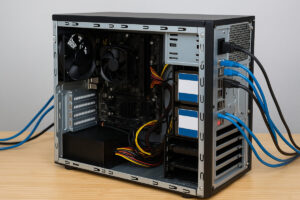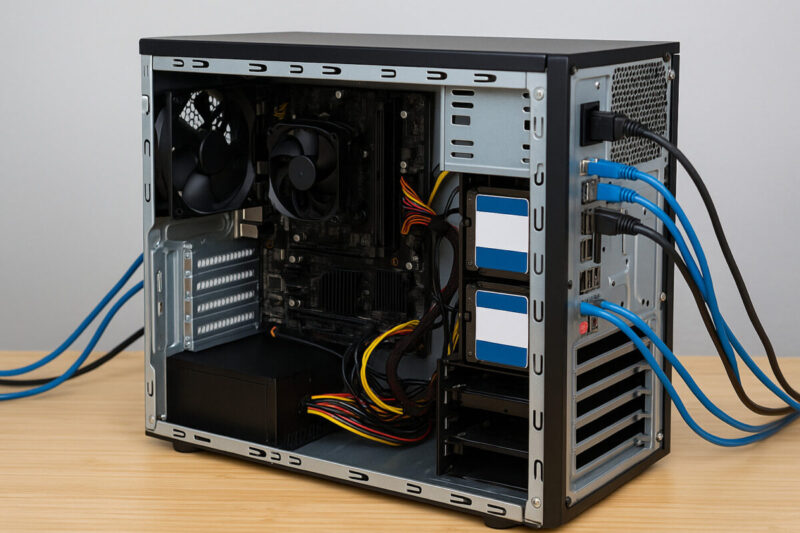How to Turn Your Old Computer into a Server (and Save Big in the Process)

Posted by Author: Alex
in Category: Repurposing IT |
If you’ve got an old desktop collecting dust, don’t be so quick to recycle it. With just a bit of time and effort, you can repurpose that aging machine into a fully functional home or small business server. Whether you’re looking to host websites, store files, stream media, or run development environments, turning your old computer into a server might be smarter—and cheaper—than you think.
But how do you actually do it? Is it safe? What kind of server can it be? And most importantly—is it worth it?
Let’s break it all down.
Why Repurpose a PC Into a Server?
It’s simple: cost savings and flexibility.
-
You avoid spending thousands on rack servers or cloud hosting
-
You gain total control over your data and applications
-
It’s ideal for learning, tinkering, or running small-scale services
-
It reduces e-waste (and clears out your closet)
Perfect use cases include:
-
Home lab setups
-
Small business file storage
-
Private media streaming
-
Isolated developer environments
-
DIY backup nodes

What Type of Server Can Your PC Become?
Your old computer may not look like a server, but functionally, it can perform several key roles depending on your goals:
-
Web Server: Host personal websites or blogs using Apache, NGINX, or Windows IIS.
-
File or NAS Server: Share documents over your local network using SMB or FTP.
-
Media Server: Run Plex, Jellyfin, or Emby to stream movies and music.
-
Game Server: Host games like Minecraft or Valheim for friends.
-
VPN/Proxy Server: Securely access your network from anywhere.
-
Dev/Test Server: Use Docker, Git, or Kubernetes to build and test code.
Pro Tip: Linux distributions like Ubuntu Server or Debian are free and reliable. If you’re used to Windows, Windows 10 Pro or Windows Server works too.
Minimum Specs: What Does Your Old PC Need?
You don’t need enterprise-grade specs to get started. Many server roles are lightweight:
| Use Case | Recommended Specs |
|---|---|
| Web/File Server | 4 GB RAM, Dual-core CPU |
| Media Server | 8–16 GB RAM, Quad-core CPU |
| Dev/Test Lab | 16 GB+ RAM, SSD |
| Virtualization | 32 GB+ RAM, Multi-core CPU, SSD/HDD array |
Remember: Data integrity > flashy specs. Always prioritize stable storage (RAID, backups) and power protection.
Step-by-Step: How to Set Up Your Server
-
Pick an Operating System
-
Beginner-friendly: Ubuntu Server, Windows 10 Pro
-
Advanced: TrueNAS, Proxmox, AlmaLinux
-
-
Set a Static IP Address
Assign a fixed local IP to avoid conflicts. -
Enable Remote Access
Use SSH (Linux) or Remote Desktop (Windows) to manage it headlessly. -
Install the Services You Need
Web server? Install Apache. Media server? Set up Plex. Development? Try Docker. -
Secure Your Setup
-
Use strong passwords and enable firewalls
-
Change default ports
-
Disable unnecessary services
-
Consider two-factor authentication
-
Is It Safe to Use as a Public Server?
Here’s the honest answer: only if you know what you’re doing.
Exposing a home server to the internet without proper security can make it a hacker’s playground. If you’re not using:
-
VPN access
-
Reverse proxies
-
Auto-patching firewalls
-
Port-knocking techniques
…then it’s best to keep the server local or restrict access via VPN.
If your setup wouldn’t pass a basic cybersecurity audit, don’t use it for anything sensitive.

What’s the Cost Benefit?
Let’s look at some quick numbers:
| Option | Estimated Cost |
|---|---|
| New Rackmount Server | $1,200–$5,000 |
| Cloud Hosting (3 yrs) | $900–$3,000 |
| Repurposed PC | $0–$100 (mainly upgrades) |
If you already own the system, your only real investment is time and maybe a solid-state drive or upgraded RAM.
And best of all? No vendor lock-in, no recurring costs.
Things to Watch Out For
Before you dive in, keep these risks in mind:
-
Old hard drives can fail silently—replace them proactively.
-
Consumer PCs often lack ECC RAM and redundant power.
-
No remote management tools like IPMI or iLO.
-
Power-hungry desktops can offset sustainability gains if left running 24/7.
Want to go green? Consider using a small form factor PC or even a Raspberry Pi instead.
When It’s Time to Upgrade to a Real Server
Using an old PC is great for learning and experimentation. But if you’re running:
-
Critical business apps
-
Multiple VMs or containerized environments
-
24/7 services with SLAs
-
Remote offices or branches
…you’re better off with professional server hardware.
Consider buying refurbished servers from trusted ITAD providers like We Buy Used IT Equipment—you’ll save up to 80% off OEM pricing and still get warranties.
Final Thoughts: Is It Worth It?
Absolutely—as long as you’re clear on your goals.
Repurposing a computer into a server is a smart way to extend its life, learn new skills, and save money. It’s not a perfect solution for every use case, but for backups, homelabs, and small business needs, it’s still a winning move.
And hey—if it turns out your old system isn’t up for the job? You can still get cash for it.
Want to Turn Your Old Computer into Cash Instead?
We’ll buy your used PCs, servers, and IT equipment—fast.
-
Free Quotes
-
Certified Data Destruction
-
Nationwide Pickup
-
Enterprise & SMB Solutions






